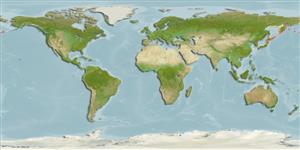Environment: milieu / climate zone / depth range / distribution range
Ecologia
marino benthopelagico; distribuzione batimetrica 2 - 100 m (Ref. 51666). Temperate
Northwest Pacific: Hokkaido Island in the Sea of Okhotsk and Russian waters of the Sea of Japan.
Size / Peso / Age
Maturity: Lm ? range ? - ? cm
Max length : 7.8 cm SL maschio/sesso non determinato; (Ref. 86872)
Short description
Morfologia | Morfometria
Spine dorsali (totale): 82; Spine anali 1; Raggi anali molli: 54; Vertebre: 87. This species is distinguished by the following characters: head and body greatly compressed laterally; body with thin sparse scales, head and end part of body without scales; no ventral fins; small pectoral fins, less than one fourth of HL; 6 rays on gill membranes, free from isthmus and form a broad fold across it; seismosensory system of body without canals; dorsal fin made up of short prickles becoming slightly thicker towards tail; membranes of dorsal and anal fins fused with caudal fin; principal rays of caudal fin branched; reduced pyloric caeca; colour of body bright red with a dark spot crossed by a light-colored vertical band above the upper edge of gill slit and extending into dorsal fin, and the head and anterior part of the body with few discontinuous dark bands (Ref. 86872).
Lives in calcified polychaete tubes (Ref. 51666).
Life cycle and mating behavior
Maturità | Riproduzione | Deposizione | Uova | Fecundity | Larve
Miki, T., 1985. New genus and species of the family Stichaeidae from Hokkaido, Japan. Jap. J. Ichthyol. 32(2):137-142. (Ref. 34867)
IUCN Red List Status (Ref. 130435)
Threat to humans
Harmless
Human uses
Informazioni ulteriori
Nomi ComuniSinonimiMetabolismoPredatoriEcotossicologiaRiproduzioneMaturitàDeposizioneSpawning aggregationFecundityUovaEgg development
Age/SizeAccrescimentoLength-weightLength-lengthLength-frequenciesMorfometriaMorfologiaLarveDinamica popolazioni larvaliReclutamentoAbbondanzaBRUVS
BibliografiaAcquacolturaProfilo di acquacolturaVarietàGeneticaElectrophoresesEreditarietàMalattieElaborazioneNutrientsMass conversion
CollaboratoriImmaginiStamps, Coins Misc.SuoniCiguateraVelocitàModalità di nuotoArea branchialeOtolithsCervelliVista
Strumenti
Special reports
Download XML
Fonti Internet
Estimates based on models
Preferred temperature (Ref.
123201): 2.2 - 17.1, mean 11.5 °C (based on 28 cells).
Phylogenetic diversity index (Ref.
82804): PD
50 = 1.0000 [Uniqueness, from 0.5 = low to 2.0 = high].
Bayesian length-weight: a=0.00102 (0.00046 - 0.00225), b=3.06 (2.88 - 3.24), in cm total length, based on all LWR estimates for this body shape (Ref.
93245).
Trophic level (Ref.
69278): 3.2 ±0.5 se; based on size and trophs of closest relatives
Fishing Vulnerability (Ref.
59153): Low vulnerability (10 of 100).
